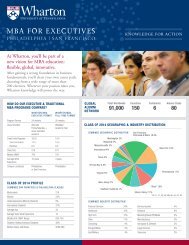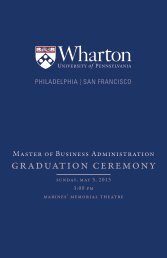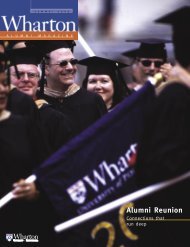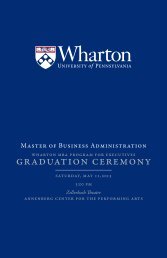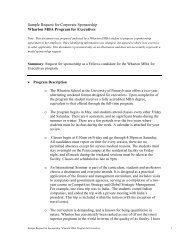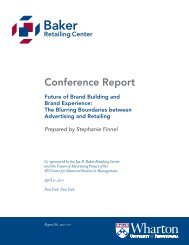wharton's prescription for health care - Wharton Magazine
wharton's prescription for health care - Wharton Magazine
wharton's prescription for health care - Wharton Magazine
You also want an ePaper? Increase the reach of your titles
YUMPU automatically turns print PDFs into web optimized ePapers that Google loves.
FEATURETHE ROCK ’N’ ROLL YEARSGoergen didn’t start out planning to be an entrepreneur. Hegrew up in a working class suburb of Buffalo to parents whodivorced shortly after he was born. His mother’s firm beliefin the importance of education, plus his own aptitude <strong>for</strong>math and science, led him to a scholarship at the Universityof Rochester where his initial plan was to study nuclearphysics. It took a summer job researching the field of airborneradioactivity to convince him that he wanted a <strong>care</strong>erwith more people interaction.“Friends suggested I might like to be president of a company.Okay, I said, how do I do that? The answer was getan MBA.” With the bulls-eye determination that wouldcharacterize his later business dealings, Goergen applied to<strong>Wharton</strong>, was granted a fellowship, finished the courseworkin 18 months and landed a job with Procter & Gamble <strong>for</strong>$7,600 a year.At P&G, after taking a long look up the brand management<strong>care</strong>er ladder, he decided to move on to TheMcCann-Erickson advertising agency. Among his successesas a senior account executive <strong>for</strong> Coca-Cola was persuadingthe company to switch its ad music from the sedate rhythmof The Limelighters to the rock ’n’ roll beat of Diana Ross,Tom Jones and the Beach Boys.In 1966, Goergen joined McKinsey & Co. and worked primarilywith large consumer goods companies like Heublein,PepsiCo and Mobil Oil. Within four years, he was made aprincipal, one of a select group that included, among others,future IBM chairman/CEO Louis V. Gerstner, Jr. andAmerican Express chairman/CEO Harvey Golub. Three yearslater, he was ready to move again.“McKinsey tended to work with big companies. I wasinterested in small companies,” says Goergen. “And at McKinsey,no matter how well you did, you were paid a salary. Iwanted significant equity.”At age 35, Goergen landed a venture capital position withDonaldson, Lufkin & Jenrette and after several years becamethe managing general partner of three private equitycapital partnerships. He did so well on one of his firstinvestments — putting $500,000 into a fledgling citizensband radio company early in 1973 and selling out two yearslater at a profit of nearly $7.5 million — that Forbes magazinewrote a two-page feature on his successes in 1977.Ironically, by the time the Forbes article appeared, Goergenhad already made decisions that, unbeknownst to him,would result in his leaving Wall Street and his home inGreenwich <strong>for</strong> a new job in Chicago and a room at theChicago Athletic Club.LOOKING FOR EQUITYWhile still at DLJ, Goergen had begun a series of “hobby”investments with several partners who, like himself, were itchingto make money on their own. He put $7,000 into DeltaFilter Corp. of Albany, N.Y., and $35,000 into the HammerBlowCorp., a Wisconsin manufacturer of couplers <strong>for</strong>agricultural and off-road vehicles.Sandwiched between those two was Valley Candle Co., amanufacturer of church and grocery candles based in Brooklyn,N.Y. Goergen, his attorney and two entrepreneurs eachcontributed $25,000, borrowed the rest and bought the company<strong>for</strong> approximately $1 million.Goergen spent his weekends advising Valley Candle management,and within one year the company had acquiredCandle Corp. of America (CCA), a Chicago-based manufacturerserving the restaurant and Hispanic markets.The deal changed Goergen’s life. Valley Candle borrowed$3 million to meet the purchase price and, in a characteristicallybold move, Goergen personally guaranteed the loan.Back then, it didn’t seem like much of a risk. “Every timewe made an acquisition and had to borrow more money,”Goergen says, “I guaranteed it. I was confident these companieswere so mismanaged that we could turn themaround.” CCA, however, was different.Within several months, it became clear to Goergen thatthe management team in Chicago was not up to runningwhat was now an $11 million company. Suddenly it lookedas if the whole operation might fail. “I went to the boardof directors and offered, under certain conditions, to comein full-time as CEO,” Goergen says, noting that the $3 millionguarantee was a “significant motivating factor” in hisdecision. “But I also saw this as an opportunity to turnaround the company and build up equity. My theory — andI have nuclear physics examples of what I mean — is thatreal freedom and independence is a function of net worth,not salary or income. And so I left Sprout to focus onCandle Corp.”Goergen moved into a rented room at the Chicago AthleticClub and began the long, slow business of “doing whatmanagement is supposed to do.”THE LEAN TEAMThe headquarters of Blyth Industries is spare. A no-frillsindustrial carpet winds throughout plainly decorated officesand ends up in a conference room furnished with a tablebought at Drexel Burnham’s bankruptcy auction. The officesite was chosen primarily <strong>for</strong> its proximity to the Greenwich,Conn., train station 200 yards away.Blyth Industries has 1,700 employees, 800 of them locatedin and around Chicago, the seat of the company’sfinancial and administrative functions and major manufacturingand distribution centers.The Greenwich headquarters, by contrast, houses a leanteam of five professionals and three support staff. Its locationreflects Goergen’s desire to stay in the community wherehe and his family have lived since 1977.17W HARTON ALUMNI MAGAZINE





